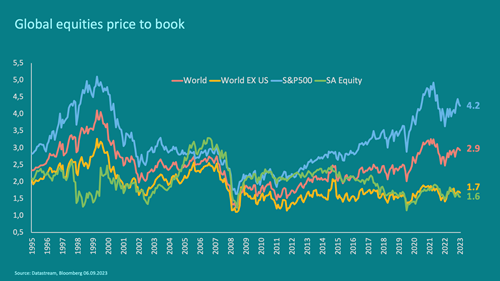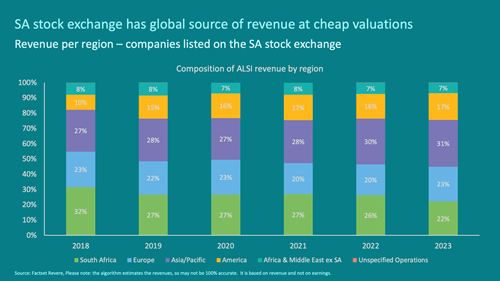SA equities: Many opportunities amid depressed valuations
Against the backdrop of being bombarded with negative news headlines on the local front, South African investors may be discouraged about finding promising investment opportunities in local equity. In an attempt to avoid potential losses, they may look to invest more offshore. However, we believe there is safety in cheap local equity valuations and that, if careful research is applied, there are many SA stocks that can offer the investor strong potential returns, over and above the risk involved. In this article we look at the risk that is being priced into equity markets currently and which factors we consider most important in stock selection, helping us choose among the many opportunities for the M&G Equity and M&G Dividend Maximiser Funds that have been created by the current conditions.
Safety in market valuations
Where investors should be concerned is when there are unknown factors that have not been priced into markets. Looking at Graph 1, which compares the price-to-book ratios (P/B) of US equity and SA equity to the rest of the world (both including and excluding the US market), the differential between the US equity market (4.2X) versus the SA equity market (1.6X) is at exceptionally wide levels compared to history, which largely aligns to the news headlines.

In the US, by contrast, the headlines suggest that everything is going well. Despite high interest rates, consumers are resilient, and companies are producing strong earnings growth.
Currently, the SA market is trading at one of the lowest P/B multiples seen for a very long time -- most of what has been happening in the news (such as slow growth, relatively high inflation, worsening government debt metrics, grey-listing by global financial watchdogs, etc.) has already been priced in. Whereas in the US, with its high market valuation, the possibility of downside data surprises or other negative news around important factors (like growth, inflation, corporate earnings, etc.) has not been priced into the market.
This should be a point of concern, as shareholder returns are strongly impacted by the starting point of the asset valuation; it can be very challenging to make money from a very high starting point.
Another attractive feature for the SA market currently is the large differential in valuations between different companies, which creates an excellent environment for active management. When companies are priced very similarly, it becomes difficult to generate alpha, given that companies all offer similar return potential.
One way that we identify opportunities in the equity market is by looking at the difference between the most expensive quartile of stocks and the cheapest quartile of stocks based on dividend yields. When this gap is wide, it means there is a big basket of cheap stocks and a basket of very expensive stocks, which gives active managers an opportunity to produce strong returns, as long as they pick correctly. In this type of market environment it makes sense to add some risk in terms of tracking error, given that the environment is good for alpha generation.
A popular misconception about the local equity market is that 100% of revenue is derived from South Africa. However, many of the companies listed on the JSE have diversified offshore over time, with the result that only about 22% of revenue of listed companies comes from this country, as shown in Graph 2. So, while the ‘doom and gloom’ scenario has been priced into SA equities, it is an environment where the revenue is in fact very well-diversified, with revenue sources ranging from the US, Europe and Asia, among others, and investors can access these offshore earnings at SA valuation levels. These features provide a great deal of safety for investors: cheap valuations as a starting point, and accessing a diverse set of revenue.

What about 2023 market performance?
Looking at the Capped SWIX Index, returns have hardly moved over the past year, largely due to weak local conditions and excessive investor pessimism. However, when the top 10 stocks are separated from the bottom 10 stocks, there is a large divergence of returns.
Companies that have underperformed for the year to date (as at 20 September 2023) are in the PGM (Platinum Group Metals) sector; but this is partly because they have come off of exceptionally high valuations and been affected by falling PGM commodity prices. This once again emphasises the importance of starting valuations when investing. On the other hand, financial and industrial stocks were undervalued for some time; then as their performances improved, so did their stock prices, so that they have been among the top performers in 2023.
If we extract the same view of the top ten stocks in the US market, it’s evident that a high concentration of stocks has accounted for nearly all the returns – generally those associated with the advanced use of artificial intelligence (AI). This means that investing in an index fund or passive strategy of any sort in that market would have exposed investors to companies trading at exceptionally high valuations --everything would have to work out perfectly for that valuation to produce market-beating future shareholder returns.
Safety in stock selection
From a stock selection perspective, one can look at building a ‘safe’ or more defensive portfolio by looking at several factors, such as balance sheet strength and pricing power.
An important measure that influences a company’s performance is the strength of its balance sheet, where relatively low debt levels or cash holdings is key. A strong balance sheet enables a company to thrive, even in a difficult macroeconomic environment, such as South Africa has experienced over the last few years. For example, it can allow a company to invest for future growth when its competitors cannot, gaining competitive advantage.
When thinking of pricing power, we can consider companies like retailers that have very little pricing power. Often industries start with significant pricing power, which diminishes as the industry matures. In the current environment, both food and clothing retailers are struggling to pass on the full extent of high inflation due to both the weak consumer and a very mature market where retailers are competing for market share.
What investors need to look for is a business with a competitive advantage, and can also continuously increase their prices in line with inflation. This allows them to maintain steady margins through economic downturns. So, companies with a history of very stable margins are often good investment choices when times are tough.
The overriding factor, however, remains valuation. There could be, for example, an exceptional company with stable, high margins and a strong balance sheet; but if you’re paying a high price for it, there is still a higher probability of losing money than of making good shareholder returns. When investing, the most important question to ask is: what is the valuation on offer?
On a forward P/E basis, the SA market is at one of the cheapest levels in a very long time, so any positive improvement from this point has not been priced into the market. This is where the greatest opportunity exists to invest in SA equities.
When going offshore, there is also the consideration of currency risk. At the moment, not only is the US market expensive, but the US dollar is also very strong. One needs to consider the implications of taking money out of a cheap market like South Africa, with a cheap currency, and moving it into an expensive market with a strong currency.
At M&G Investments, when it comes to our market views and portfolio construction, we look beyond the surface to carefully consider the risks and evaluate opportunities based on valuations and robust research and analysis. In our view, continued headwinds and pessimism have left strong companies at very attractive valuations, which in turn have created opportunities for investors willing to brave the negative narrative. This approach has delivered alpha and driven admirable long-term performance in our M&G Equity and M&G Dividend Maximiser Funds over the past 20 years, and we believe these funds are well-positioned to continue doing so over time.
Share
Did you enjoy this article?
 South Africa
South Africa Namibia
Namibia




 Get the Newsletter
Get the Newsletter